Spiraea japonica
As an urban farmer, I tend to give most of my attention to food-producing plants. I have little time and energy to devote to my ornamentals and I’ll admit that the poor things often suffer from borderline neglect.
For this reason, I choose my ornamental plants carefully. They need to pass the “Tabitha test.” This means they absolutely must be low maintenance.

We link to vendors to help you find relevant products. If you buy from one of our links, we may earn a commission.
The resilient Japanese spirea is one of my go-to shrubs for when my garden design whims get the best of me. You see, I have this unfortunate habit, some might call it a gardening quirk, of constantly rearranging my plants.
It’s like a game of musical chairs, but for shrubs. And Japanese spireas are never sore losers. They’re tough, resilient, and easy to care for. Even through all the digging up and replanting, my Japanese spirea shrubs never hold a grudge.
If you’re looking for a plant that’s as forgiving as it is beautiful, you’ve come to the right place.
This species belongs to the large Spiraea genus and you can read more about them in our comprehensive growing guide. Here I’ll be focusing solely on how to grow Spiraea japonica.
Buckle up, fellow garden enthusiasts; we’re about to dive into the wonderfully adaptable world of Japanese spirea!
Here’s what I’ll cover:
What You’ll Learn
Ready to learn all about this shrub? Let’s go!
What Is Japanese Spirea?
Japanese spirea, S. japonica, is a flowering deciduous shrub. Native to Japan and China, this plant has made itself at home and become a garden favorite here in the United States and Canada.
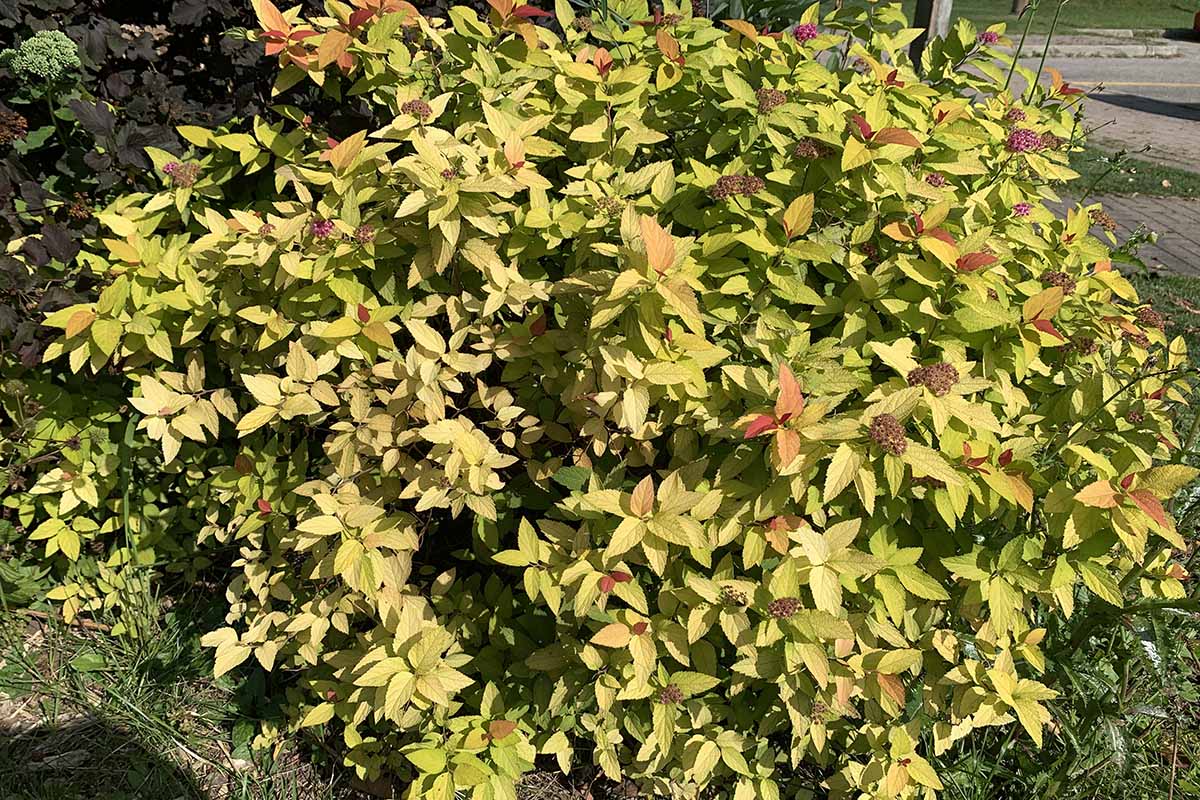
It’s a member of the Spiraea genus within the Rosaceae family. This plant sometimes goes by the common name Japanese meadowsweet.
Japanese spirea is sometimes confused with other plants in the Spiraea genus, including S. alba and S. tomentosa. However, its unique leaf shape, corymb structure, plus flower size and colors set it apart.
There are a number of hybrids and cultivars of Japanese spirea available, each with its own unique characteristics. Like other spireas, this species is hardy in USDA Zones 3 to 8.
It’s a versatile little number, growing two to six feet high and up to seven feet wide. With an upright and broadly mounded form, Japanese spirea creates dense thickets of thin, wiry stems.
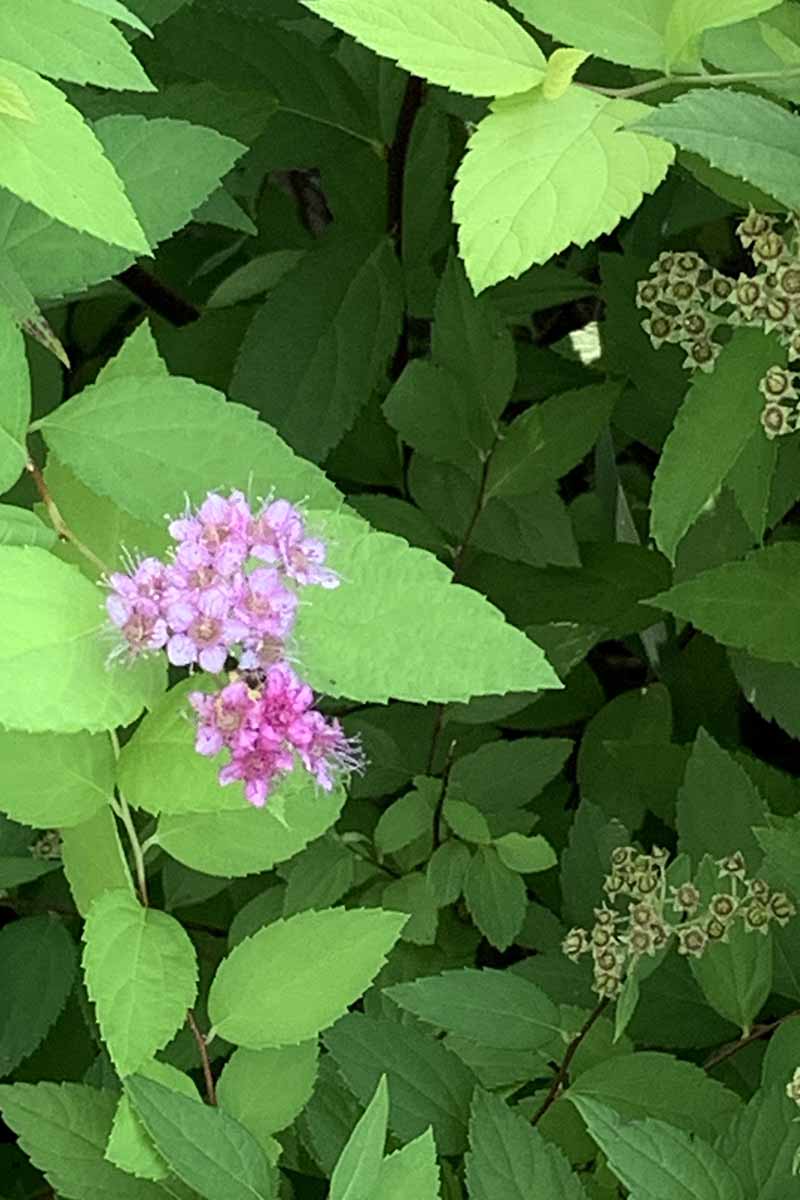
The plant is drought-tolerant once established and blooms in early summer with white, pink, or purple flowers that attract butterflies and other pollinators. It’s often the last of the spirea bushes to bloom each year.
At its peak, Japanese spirea boasts a lush display of lustrous green leaves in different shades of golds and greens, one to three inches long, with serrate margins.
The wiry, freely branching, erect stems are brown to reddish-brown, adding to its visual appeal.
In fall, the leaves change color to gold, orange, or red. In winter, the plant will lose its leaves, but still manages to look fabulous with its erect habit and snow-catching branchlets. Come spring, it’s back in action as a riot of color with new leaves and flowers.
Cultivation and History
Japanese spirea was introduced to the United States in the late 19th century, most likely sometime between 1870 and 1890, as an ornamental plant.
It quickly gained popularity in gardens and landscapes thanks to its hardiness, adaptability, and aesthetic appeal. It has naturalized in North America from New England down through the Appalachians, into Tennessee, Georgia, and Indiana, and in parts of Canada.
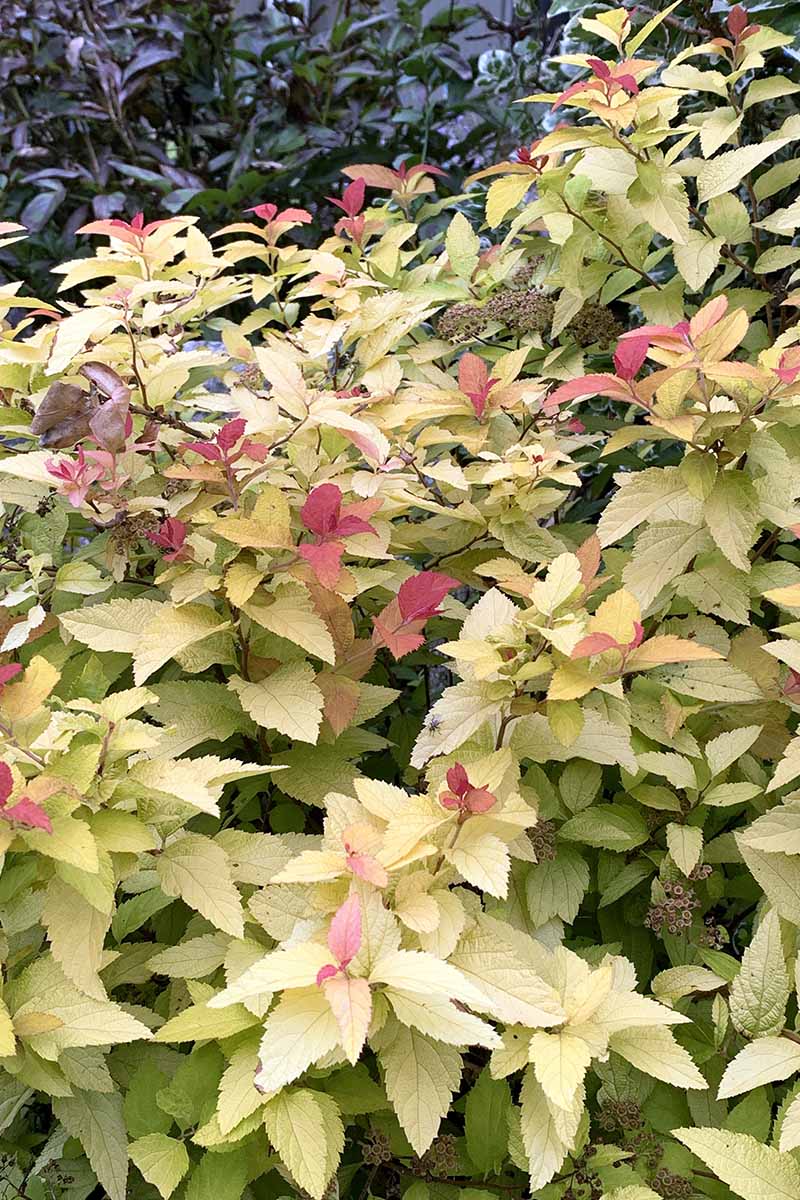
However, its rapid spread and ability to outcompete native vegetation has become a concern in some areas of the country.
In the United States, Japanese spirea has been identified as invasive in several states, particularly in the Mid-Atlantic region. It thrives in a variety of habitats, including meadows, open woodland areas, and along waterways.
The plant’s invasive nature is attributed to its prolific seed production and fast growth rate, which allows it to quickly colonize new areas, displacing native flora in the process.
To mitigate the invasive spread of Japanese spirea, mechanical removal and herbicide treatments are commonly recommended by management authorities. For those who still wish to include this plant in their gardens, selecting sterile, non-invasive cultivars is advised.
I’ll cover a few specifics later on, but some sterile cultivars include ‘Crispa,’ ‘Dart’s Red,’ ‘Neon Flash,’ and those in the Double Play® series.
Japanese Spirea Propagation
Japanese spirea reproduces easily in the wild. One plant is capable of producing hundreds of seeds that can remain viable in the soil for years.
Growing the species plant from seed is easy, but this doesn’t mean it’s the best method of propagation. It could take two years or more for the plant to reach a desirable size for your landscape design.
You can collect seeds from your own plants or purchase from online distributors. Note that seeds collected from hybrids and cultivated varieties may be sterile and will not grow true to the parent plant.
Place seeds between layers of damp paper towel until they sprout, then transfer the sprouted seeds to soil. Or simply surface sow and keep them moist until they sprout.
In commercial cultivation, this shrub is often propagated via softwood cuttings. These cuttings can be rooted during the summer. Additionally, hardwood cuttings can be rooted in the fall.
Another method, known as layering, involves pegging down a branch in the spring and potting it up in the fall once roots are established.
To learn more about propagating spirea from cuttings and via layering, visit our guide.
Spireas produce suckers. You can dig up these suckers and nurture them as individual plants.
It’s also possible to divide an established spirea in the spring or fall to propagate new plants. In my own experience, dividing is a little risky.
I’ve divided my own Japanese spireas with about an 85 percent success rate. Divisions, including the parent plant, can become weakened in the process, and they always need time to bounce back, so proceed with caution.
You can learn more about how to divide perennials in our guide.

The quickest and most reliable method for busy home gardeners, however, is to purchase a potted Japanese spirea plant from a reputable grower and transplant it into your garden.
Purchasing a container-grown shrub not only ensures that you know what you’re getting – as propagating from cuttings and layering does – but the young shrub will be a few years older, healthy, and prepped for success.
I’ll give you some tips on where to purchase later, but first let’s take a look at the transplanting process.
Transplanting
Before you grab your shovel, let’s stop for a moment and talk about spacing. This shrub can grow up to seven feet wide at maturity, so give it some room to spread.
Plan for three to six feet between your new shrub and its plant neighbors. Check the nursery tag for specific spacing requirements.
Spireas are easy to transplant. Start by digging a hole as deep as your shrub’s root ball and about twice as wide.
Although these shrubs can tolerate poor soil conditions, why not try to give them their best shot at a healthy life?
If you happen to have some organic material like compost or well-rotted manure on hand, add a scoop into the planting hole. If you don’t have it, no big deal! Proceed without it.
If you’re transplanting a potted Japanese spirea shrub, remove it from its container and inspect the roots. Loosen pot bound roots and trim any that look unhealthy or damaged.
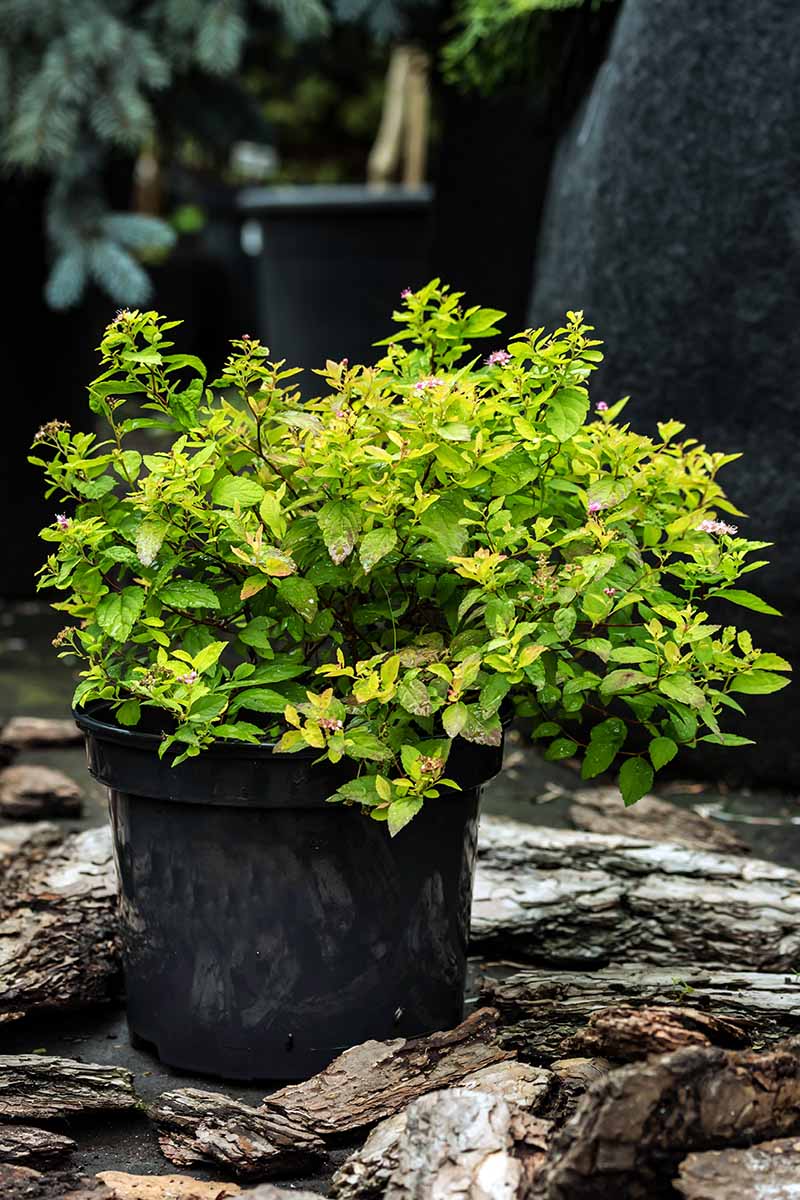
In the case of a bare root shrub, inspect it carefully and trim any damaged or diseased roots before planting. Then make a small mound in the bottom of the hole to support the roots.
Place the plant into the hole, ensuring that the top of the root ball is level with the surrounding soil. If your shrub has bare roots, gently spread the roots out over the mounded soil.
Next, backfill the hole with soil, gently tamping it down as you go to eliminate air pockets around the roots. Once the plant is securely in place, give it a good watering to help settle the soil.
Add a layer of mulch, about an inch or two thick, on top of the root zone to retain moisture. Keep the mulch a few inches away from the stems. If mulch sits against the stems it can encourage disease.
How to Grow Japanese Spirea
Now that you know just how easy it is to transplant a Japanese spirea, let’s discuss everything this shrub needs to grow to its full potential.
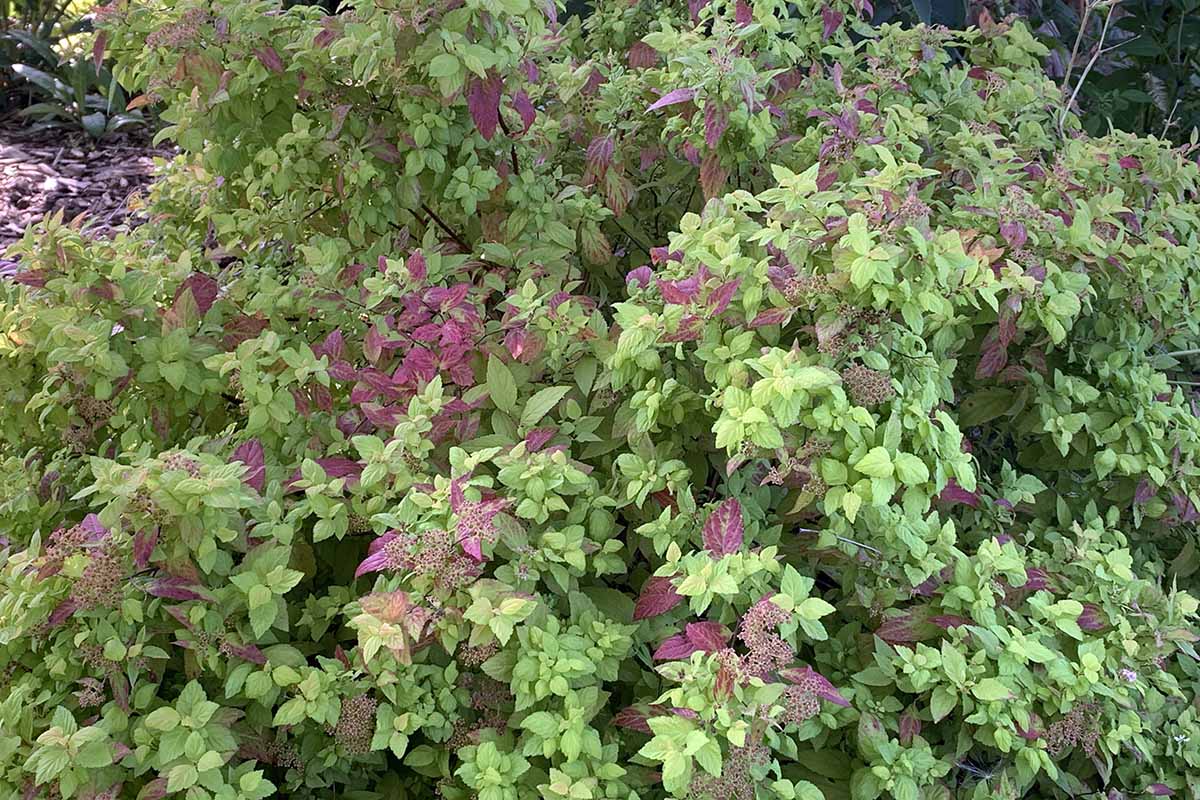
When it comes to soil, S. japonica is generally a forgiving plant. It thrives best in moist, well-drained soils but can tolerate dry sites as well.
While the soil pH should ideally be lightly acidic to neutral – between 6.0 and 7.0 – Japanese spirea is not overly picky and can even tolerate slightly alkaline conditions.
I will note that if you’re dealing with highly alkaline soils, you might notice some chlorosis, or yellowing of the leaves. Test your soil and amend accordingly if you notice this abnormal discoloration.
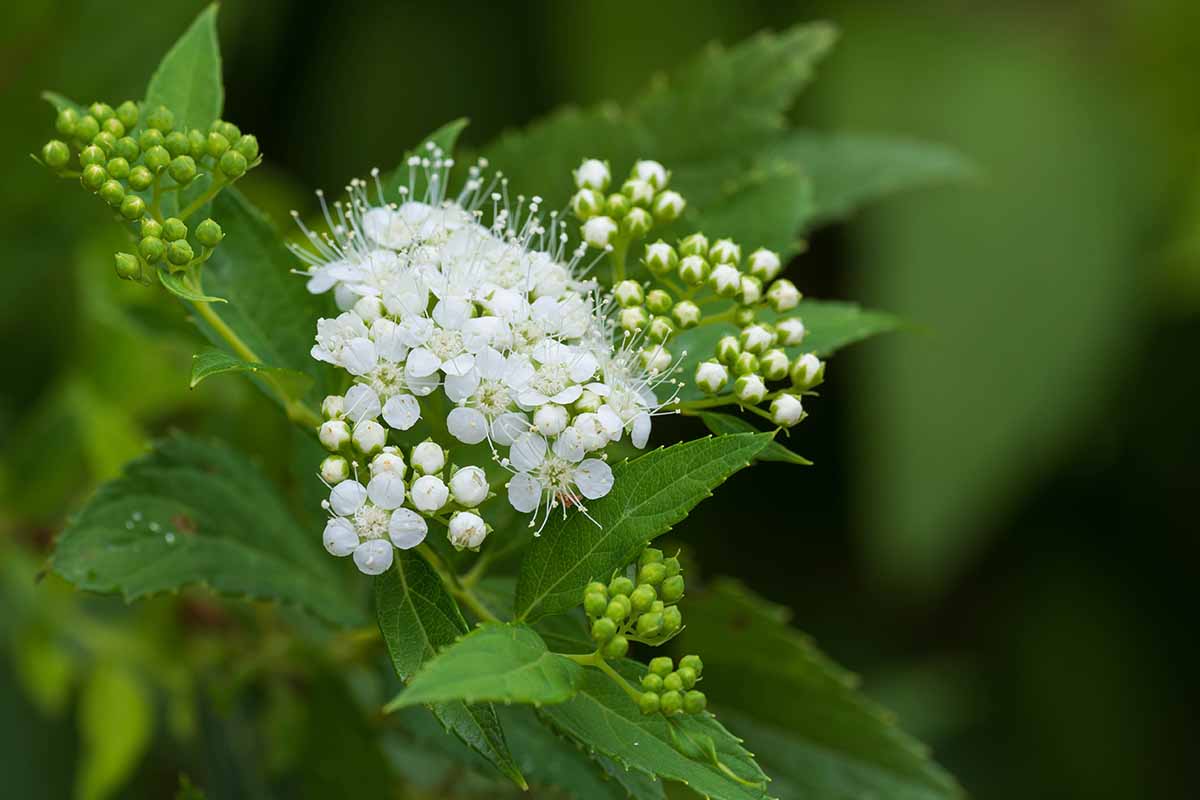
This species is hardy in USDA Zones 3 to 8, making it a versatile choice. It loves full sun but can also tolerate partial shade. So as long as we’re not talking about deep shade, most locations on your property will accommodate these shrubs.
As for fertilizing, less is more. Japanese spireas don’t have high nutrient demands. A balanced, slow-release fertilizer applied in early spring will suffice.
Gardener’s Best All-Purpose Organic Fertilizer
If you’re looking for a recommendation, check out this granular fertilizer called Gardener’s Best All-Purpose Organic Fertilizer available at Gardener’s Supply Company. It’s available in one-, five-, and 25-pound packages.
It’s best to err on the side of caution as overfertilizing can damage these plants. Excess fertilizer can also disrupt healthy microorganisms in the soil and increase salt concentration.
Always read and follow the package instructions carefully.
Well-rotted manure also makes a good fertilizer while supporting and improving soil health at the same time. Add a scoop to the soil at the base of each shrub in the spring and your plants will love you for it!
When it comes to watering, this bush is moderately drought-tolerant once established, but it does appreciate consistent moisture, especially during dry spells. In the absence of regular rainfall, you’ll need to supplement with watering.
That said, spirea is not a fan of waterlogged conditions, so well-drained soil is key.
A good rule of thumb is to water deeply and then allow the top two inches of soil to dry out between waterings.
This approach encourages deeper root growth, making the plant more resilient in the long run. So, no need to hover with the hose; this shrub’s got a laid-back attitude about hydration.
One last note about watering: deciduous shrubs like spirea go dormant in winter. During this time, plants don’t require as much water as they do during the growing season. But should you water at all?
If you live in a Zone where the ground freezes, refrain from watering during dormancy, as this may damage the roots.
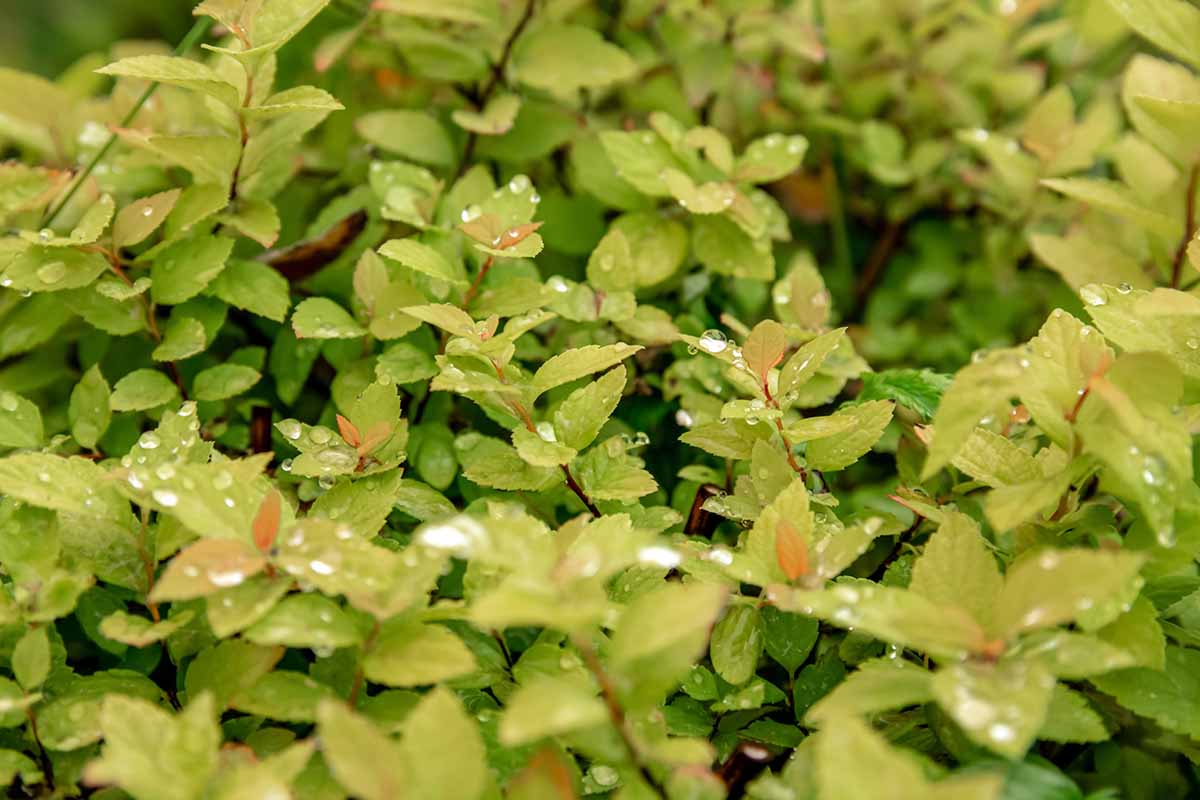
Only water if the temperature is above 40°F (4°C). If conditions are dry, check your soil and if necessary, give your shrubs some water. This might be once or twice a month.
Whether you’re a seasoned gardener or a newbie with a green thumb, S. japonica offers a lot of flexibility.
It’s like that easy-going friend who’s happy to hang out wherever, whenever. We could all use more friends like Japanese spirea, couldn’t we?
Just give it some sun, a bit of space, and it’ll reward you with a vibrant display from spring to fall. All in all, Japanese spireas are relatively low maintenance. I don’t know about you, but I’ll take it!
Growing Tips
- Choose a location with full sun to part shade.
- Plant in well-draining soil.
- Fertilize sparingly in spring with well-rotted manure or a balanced, slow-release fertilizer.
- Water when the soil is dry two inches down and be careful not to overwater.
Pruning and Maintenance
Japanese spirea grows naturally in a somewhat rounded shape. In my experience, however, it can become a little wild and unruly at times. If you want to tame the beast, consider pruning.

When it comes to pruning spirea, timing is everything. The flowers form on new wood, so aim to prune your shrub in late winter or early spring to control its size and shape.
Another opportune time for pruning is right after the flowers fade. Deadheading spent flowers and a light shear encourages colorful new growth and keeps the shrub looking fresh.
To make quick work of pruning, I like to use my Fiskars PowerGear2 Hedge Shears. The long blades let me work swiftly and efficiently as I shape my shrubs.

Fiskars PowerGear2 Hedge Shears
You can find these shears available at Amazon.
Dead and damaged branches should be removed in late winter or early spring. You can also remove the oldest, woodiest stems every couple of years to rejuvenate the plant.
Selectively clip these close to the base of the plant. This will help maintain a naturally rounded habit without much effort.
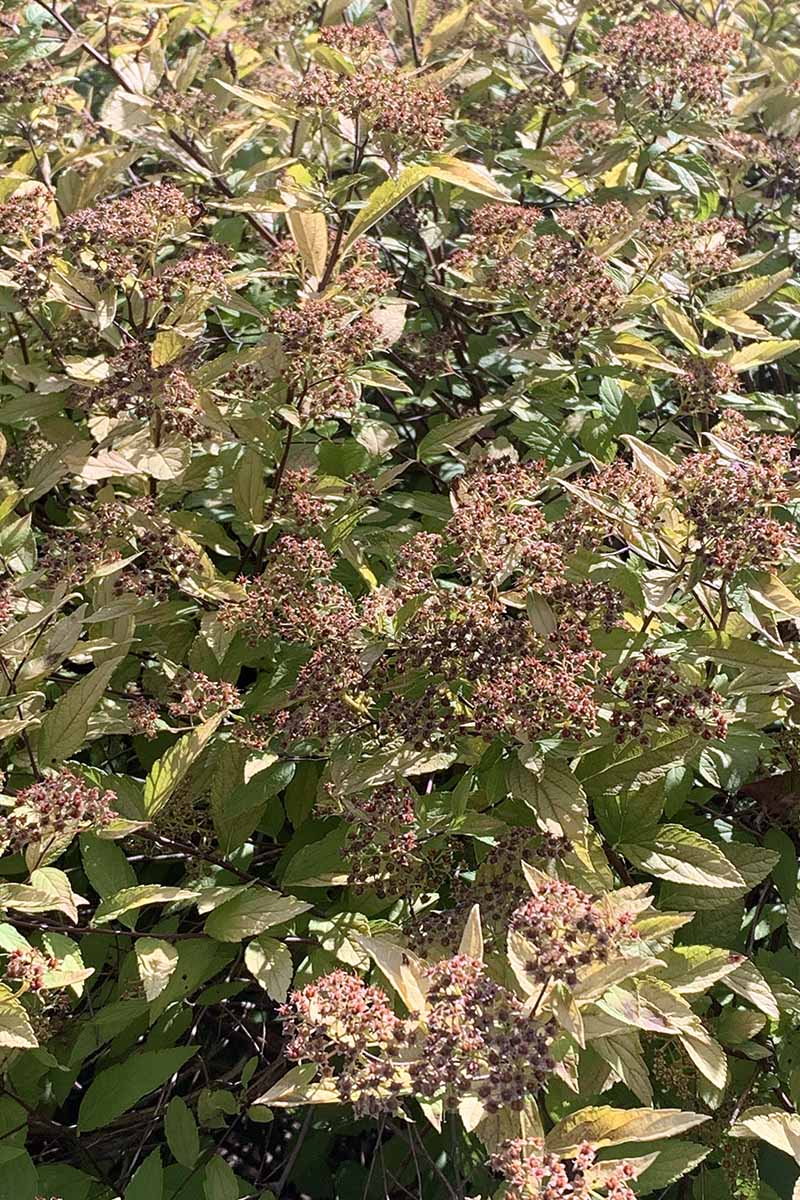
If you want to keep your spirea compact, you can opt to trim the whole shrub back more aggressively. You can cut the whole plant back by 30 percent, or you can take it all the way to the ground.
Just remember that you should only attempt this while the plant is dormant in late winter or early spring.
If you’re dramatically reducing the size of your shrub, it will need some time to recover.
Avoid this option in times of severe drought as it will place unnecessary stress on your plant as it attempts to recover, and remember to maintain consistent moisture.
Read our guide to pruning spirea for full details.
Another maintenance point to consider is mulching. Mulching serves a dual purpose: it helps retain soil moisture and suppresses weeds.
This not only keeps the soil moist but also adds a neat, finished look to your planting area, and adds protection for the roots in extreme cold winters.
Visit our guide for more details about caring for your spirea during the winter.
You can also add a fresh layer of mulch in the spring to give your garden a tidy appearance and prepare it for the growing season.
Japanese Spirea Cultivars to Select
Are you falling in love with Japanese spirea and thinking about adding one or more to your landscape design?
Since this species is considered invasive in some states and provinces, check before making your decision to purchase. There are plenty of cultivars to choose from, including ones that are sterile.
Let’s take a look at a few options!
Crispa
‘Crispa,’ or crisp leaf spiraea, is a sterile hybrid cultivar with magnificent hot pink flowers and dark green leaves that are twisted and crinkled.
Leaves turn lovely shades of bronze in autumn. The unique foliage offers a change of texture to planting beds.
Its short stature of two to three feet tall and wide make it a compact choice for borders and rock gardens. This cultivar thrives in Zones 4 to 8.
Find it at Nature Hills Nursery.
Double Play Candy Corn
Double Play® Candy Corn® is a fun dwarf Japanese spirea that offers a colorful display, not only for trick-or-treat time, but throughout the year.
This compact shrub reaches a height of 18 to 24 inches and a width of 18 to 30 inches, making it ideal for small spaces and containers.
It starts the growing season with red leaves that mature to golden yellow and eventually turn pumpkin orange.
Deep pinkish-purple flowers bloom from spring to early summer, adding another layer of color. This cultivar is hardy in USDA Zones 4 to 7.
Don’t wait for Halloween to plant this sweet treat! Double Play® Candy Corn® can be purchased from Planting Tree.
Double Play Doozie
Double Play® Doozie® is another sterile cultivar, so you can rest assured it will not escape your garden.
In spring the leaves open to a brilliant red color before turning lush green, then on to copper and gold in fall. Blooms explode in shades of rich purple-red from early summer and continue until first frost.
This shrub tops out at three feet tall and is suited for Zones 3 to 8. Check it out at Nature Hills where it’s available in #3 containers.
Neon Flash
‘Neon Flash’ is another sterile cultivar. It bursts onto the spring scene with flashy reddish-pink flowers. Foliage emerges red, before turning green, then transitions to shades of burgundy in fall.
This bush reaches up to three feet tall and wide and you can grow it successfully in Zones 4 to 8.
Nature Hills carries ‘Neon Flash’ in #1 containers as well as one- to two-foot bare root plants.
Magic Carpet
Magic Carpet spirea, aka S. japonica ‘Walbuma,’ is a compact, spreading cultivar that adds a splash of color to any garden.
Its young shoots and leaves start off red and mature to various shades of gold depending on the light conditions.
In full sunlight, the mature leaves turn golden, while in partial shade, they take on a greenish-gold hue. The shrub produces clusters of bright pink flowers, making it a vibrant addition to your garden.
It is well-suited for Zones 3 to 8 and reaches a height of one to two feet with a spread of two to three feet. Note that this cultivar is not sterile and will produce viable seed.
Hop on for a ride! You can find Magic Carpet available as one- to two-foot bare roots and in #3 containers at Nature Hills.
Learn more about growing magic carpet spirea here.
Managing Pests and Disease
Japanese spirea aren’t generally bothered by pests and diseases. Although it would be unlikely, if you notice any herbivores munching on your shrubs you may want to take precautions such as installing deer-resistant fencing.
I always recommend a holistic first approach when dealing with insects and disease in the garden. This begins with preventative practices including good hygiene and sanitation, proper watering methods, and biodiversity to encourage beneficial predatory insects.
Let’s take a look at some common pests and diseases that might damage your shrub:
Insects
It’s important to remember that insects can be responsible for introducing disease-causing pathogens, so knowing what to watch out for is key to keeping your plants healthy.
Here are the main insects to be aware of:
Aphids
Aphids are small, soft-bodied insects that are known for sucking plant sap. The spirea aphid, Aphis citricola, is the particular species that targets spirea plants.
When aphids attack, they cause the leaves to curl, and can also lead to the development of sooty mold due to their secretion of honeydew.
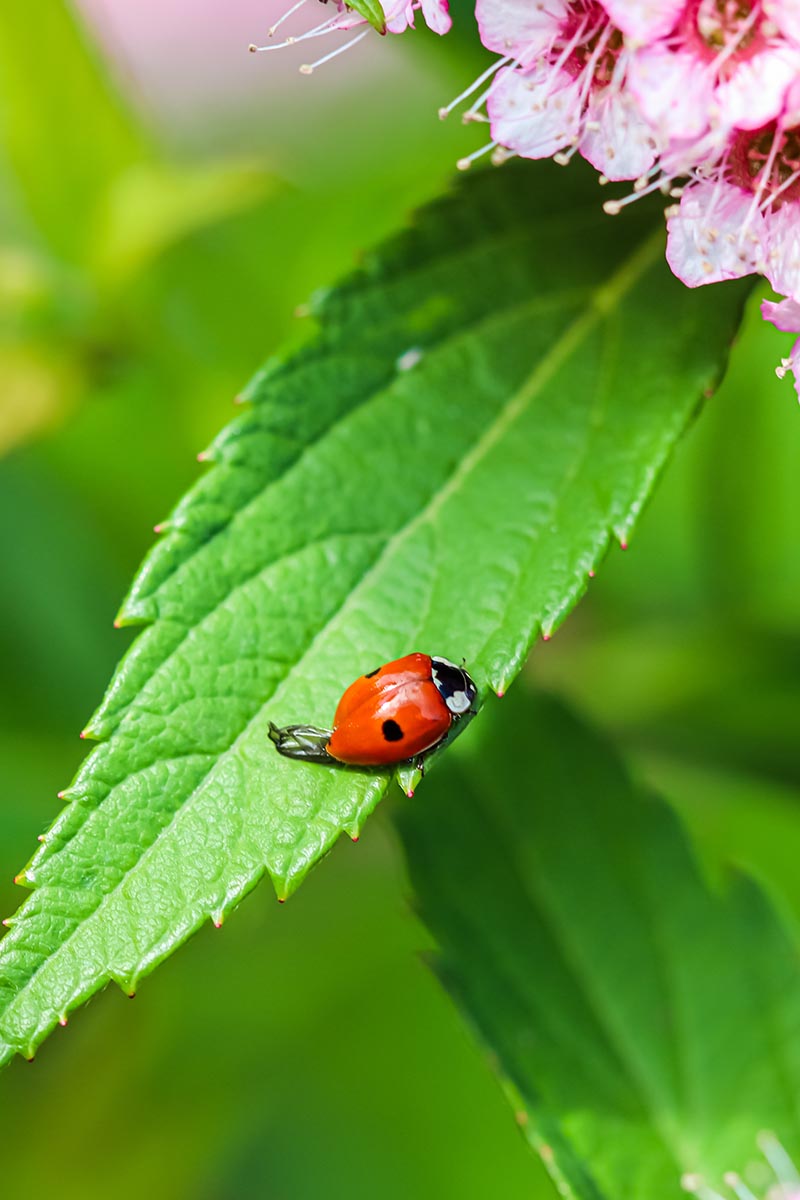
To control aphids, you can use sprays of insecticidal soap or neem oil. Biological controls like the introduction of ladybugs can also be effective in keeping aphid populations in check.
Learn more about how to manage aphids in our guide.
Leaf Rollers
Leaf rollers are actually caterpillars, the larvae of tortrix moths, and they use leaves as a form of protection, rolling them around themselves while they feed.
This causes the leaves to curl and can eventually lead to defoliation if not addressed.
To manage leaf rollers, an insecticide containing the beneficial bacteria Bacillus thuringiensis (Bt) can be effective.
Biological control methods also include the introduction of natural predators like tachinid flies, ichneumonid wasps, lacewing larvae, and assassin bugs. Manual removal is also an option if you prefer a hands-on approach.
Scale
Scale insects are small and immobile, attaching themselves to the stems and leaves of plants. They suck sap from the plant, which can weaken it and lead to the yellowing of leaves.
To treat scale, horticultural oils can be effective, especially when applied during the insects’ mobile crawler stage.
Natural predators like parasitic wasps and lady beetles can also help to reduce scale populations. Manual removal is an option, along with pruning of heavily infested stems.
Learn more about scale insects in our guide.
Disease
There are a few diseases that can target your Japanese spirea. Let’s investigate symptoms and treatment options.
Gray Mold
Gray mold, caused by the fungus Botrytis cinerea, is a disease that can affect various parts of the Japanese spirea plant, including stems, buds, flowers, and leaves.
The disease manifests as a grayish web of mycelium on the affected tissue, especially when humidity is high. Symptoms may vary depending on the plant parts attacked and growing conditions.
To manage gray mold, it’s crucial to control the environment by avoiding overhead watering, improving air circulation, and applying fungicides as needed.
Deadheading spent flowers and removing all infected plant tissue are also recommended.
Fireblight
Fireblight is a bacterial disease caused by Erwinia amylovora, commonly affecting apples, pears, and related species like Japanese spirea. The disease manifests as wilting and blackening of leaves, making them appear as if scorched by fire.
One of the most characteristic symptoms is the curling of affected shoots into “shepherd’s crooks.”
To manage fireblight, it’s essential to prune out infected branches, ideally during winter dormancy.
Bactericidal sprays like copper sulfate can be used during the bloom period, and if you’re dealing with a heavily infected plant it’s best to remove it from your garden and dispose of it in the trash to avoid any potential spread.
Powdery Mildew
Powdery mildew is a common fungal disease that manifests as white to gray powdery spots or blotches on the leaves, stems, and buds of the Japanese spirea.
The disease is often most severe on young leaves and green shoots. While it doesn’t significantly harm the health of the plant, it can affect its appearance.
To manage powdery mildew, consider cultural control practices like planting in full sun and removal and disposal of fallen leaves. Proper spacing and avoiding excessive fertilization can also help in controlling the disease.
Learn more about how to treat powdery mildew in our guide.
Root Rot
Root rot in Japanese spirea can be caused by fungi such as Phymatotrichopsis omnivorum and water molds in the Phytopthora genus.
Root rot is most prevalent in soils that are poorly draining, compacted, and in locations where water collects and stands. It can be compounded when exposed to high summer temperatures.
Symptoms often appear from June through September when soil temperatures reach their peak. Affected plants may display wilted leaves that turn brown but remain attached.
The roots of infected plants will become severely decayed and may be covered by a fuzzy, tan-colored mold.
Chemical treatments have not been successful in controlling an advanced case of root rot.
Prevention is key, so choose the planting location wisely. If root rot takes over, you should remove and dispose of the affected plant. Avoid planting the same species in the same location.
Verticillium Wilt
Verticillium wilt is a soil-borne disease caused by the fungi Verticillium albo-atrum and V. dahliae. It can affect a wide range of plants, including Japanese spirea. The fungi infect the plant through the roots and disrupt water and nutrient flow.
The disease manifests as wilting, yellowing, and browning of the leaves, often starting on one side of the plant. As the disease progresses, entire branches may die back.
Management of verticillium wilt is challenging once a plant is infected. If infection occurs, pruning out affected branches can help manage the disease, but it’s difficult to eradicate entirely.
The best approach is preventative. Sanitize garden tools, encourage good soil and plant health via moisture management and air circulation, and avoid planting susceptible species in previously infected areas of your garden.
Best Uses for Japanese Spirea
Japanese spirea is a “jack-of-all-trades” – versatile, durable, and oh-so-charming.
With a plethora of cultivars to choose from, you’re not just adding another plant to your garden – you’re adding a personality!

But it’s not only about its personality; this shrub is a multitasker. Use it as a border to define your garden spaces or as a foundation planting to give your home that welcoming, lived-in look.
It’s also a favorite for mass plantings and specimen focal points, where its seasonal changes – from spring’s first buds to fall’s fiery hues – can truly shine.

And let’s not forget the winter interest; even when the leaves have fallen, the intricate branching pattern adds a touch of drama to a snowy landscape.
So go ahead, let your creativity run wild and make Japanese spirea the star of your garden stage!
Quick Reference Growing Guide
| Plant Type: | Deciduous perennial flowering shrub | Flower / Foliage Color: | Pink, purple, white; yellow, green, chartreuse |
| Native to: | China, Japan | Maintenance: | Low |
| Hardiness (USDA Zone): | 3-8 | Tolerance: | Air pollution, deer, drought, erosion, light shade, poor soil |
| Bloom Time/Season: | Spring, summer | Soil Type: | Loamy |
| Exposure: | Full sun to part shade | Soil pH: | 6.0-7.0 |
| Spacing: | 3-6 feet | Soil Drainage: | Well-draining |
| Planting Depth: | Same depth as container (transplants) | Attracts: | Bees, butterflies |
| Height: | 2-6 feet | Companion Planting: | Barberry, coral bells, grasses, hydrangea, rhododendron, sedum, weigela |
| Spread: | 4-7 feet | Uses: | Border, foundation planting, hedge, mass planting, rock garden, specimen |
| Growth Rate; | Fast | Family: | Rosaceae |
| Water Needs: | Low | Genus: | Spiraea |
| Pests & Diseases: | Aphids, leaf rollers, scale; gray mold, fireblight, powdery mildew, root rot, verticillium wilt | Species: | Japonica |
A Garden Gem
Fantastic! We’ve come a long way, haven’t we? From understanding the ins and outs of Japanese spirea to navigating its diverse cultivars, we’ve dug deep – literally and metaphorically – into this garden gem.
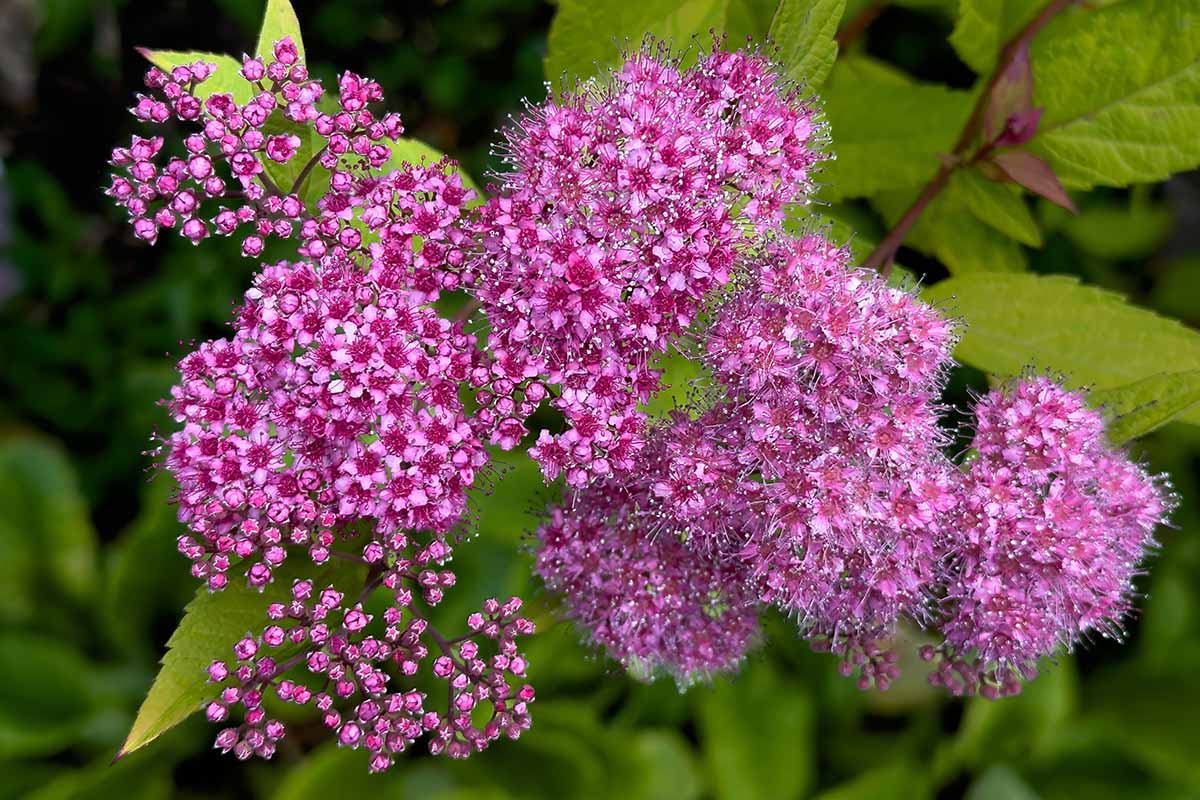
We’ve tackled its history, its likes and dislikes in soil and climate, and even how to keep it healthy and pest-free. And now we’re all educated on the potential for this plant to become invasive in some regions, do your homework before planting, folks!
As you plan your next planting, remember this shrub’s forgiving nature and versatile beauty. It’s practically begging to be the newest member of your garden family.
Got questions or your own spirea stories to share? We’d love to hear from you in the comments below.
And for more information about growing spirea in your garden, check out these guides next:

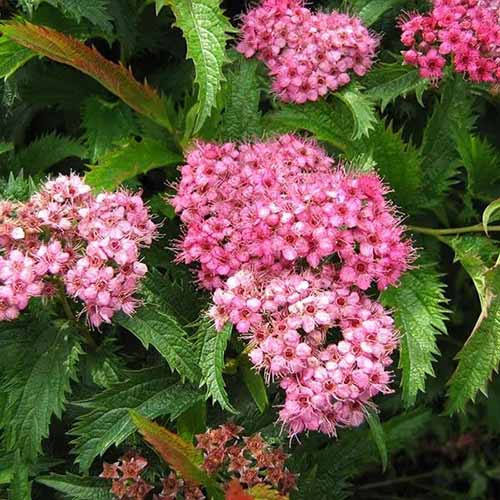
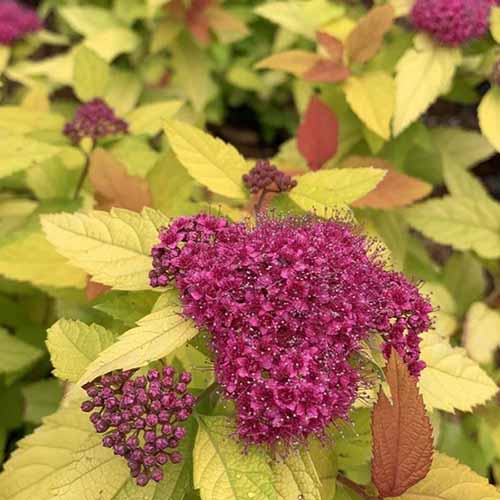


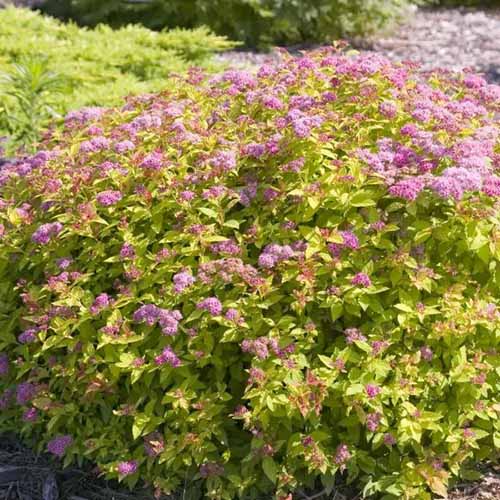
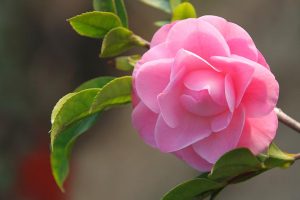
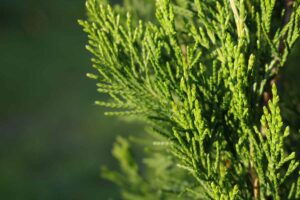

Thank you—very comprehensive. We just love our Double Play Candy Corn.
You’re quite welcome, Richard. I’m glad you found this guide helpful. And I agree – the Double Play Candy Corn has such bright, vivid foliage and blooms. What’s not to love, right?